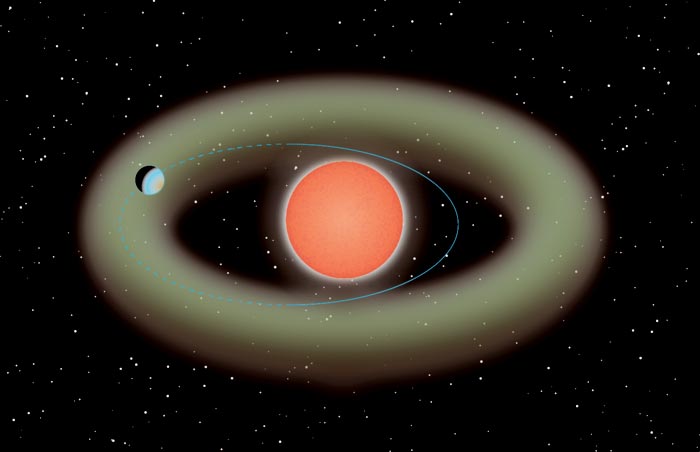Super-earth skimming habitable zone of red dwarf

The green region represents the habitable zone where liquid water can exist on the planetary surface. The planetary orbit is shown as a blue line. Ross 508 b skims the inner edge of the habitable zone (solid line), possibly crossing into the habitable zone for part of the orbit (dashed line).
Credit: Astrobiology Center
A super-Earth planet has been found near the habitable zone of a red dwarf star only 37 light-years from the Earth. This is the first discovery by a new instrument on the Subaru Telescope and offers a chance to investigate the possibility of life on planets around nearby stars. With such a successful first result, we can expect that the Subaru Telescope will discover more, potentially even better, candidates for habitable planets around red dwarfs.
Red dwarfs, stars smaller than the Sun, account for three-quarters of the stars in the Milky Way Galaxy, and are abundant in the neighborhood around the Sun. As such, they are important targets in the search for nearby extra-solar planets and extraterrestrial life. But red dwarfs are cool and don’t emit much visible light compared to other types of stars, making it difficult to study them.
In the infrared wavelengths red dwarfs are brighter. So the Astrobiology Center in Japan developed an infrared observational instrument mounted on the Subaru Telescope to search for signs of planets around red dwarf stars. The instrument is called IRD for Infrared Doppler, the observational method used in this search.
The first fruits of this search are signs of a super-Earth four times the mass of the Earth circling the star Ross 508, located 37 light-years away in the constellation Serpens. This planet, Ross 508 b, has a year of only 11 Earth-days, and lies at the inner edge of the habitable zone around its host star. Interestingly, there are indications that the orbit is elliptical, which would mean that for part of the orbit the planet would be in the habitable zone, the region where conditions would be right for liquid water to exist on the surface of the planet. Whether or not there is actually water or life are questions of further study.
To have the very first planet discovered by this new method be so tantalizingly close to the habitable zone seems too good to be true and bodes well for future discoveries. Bun’ei Sato, a Professor at the Tokyo Institute of Technology and the principal investigator in this search comments, “It has been 14 years since the start of IRD’s development. We have continued our development and research with the hope of finding a planet exactly like Ross 508 b.”
These results appeared as Harakawa et al. “A Super-Earth Orbiting Near the Inner Edge of the Habitable Zone around the M4.5-dwarf Ross 508” in Publication of the Astronomical Society of Japan on June 30, 2022.
Journal: Publications of the Astronomical Society of Japan
DOI: 10.1093/pasj/psac044
Method of Research: Observational study
Subject of Research: Not applicable
Article Title: A super-Earth orbiting near the inner edge of the habitable zone around the M4.5 dwarf Ross 508
Article Publication Date: 30-Jun-2022
Media Contact
Nobuhiko Kusakabe
AstroBiology Center, NINS
nb.kusakabe@nao.ac.jp
Original Source
https://www.nao.ac.jp/en/news/science/2022/20220801-subaru.html
All latest news from the category: Physics and Astronomy
This area deals with the fundamental laws and building blocks of nature and how they interact, the properties and the behavior of matter, and research into space and time and their structures.
innovations-report provides in-depth reports and articles on subjects such as astrophysics, laser technologies, nuclear, quantum, particle and solid-state physics, nanotechnologies, planetary research and findings (Mars, Venus) and developments related to the Hubble Telescope.
Newest articles

Innovative 3D printed scaffolds offer new hope for bone healing
Researchers at the Institute for Bioengineering of Catalonia have developed novel 3D printed PLA-CaP scaffolds that promote blood vessel formation, ensuring better healing and regeneration of bone tissue. Bone is…

The surprising role of gut infection in Alzheimer’s disease
ASU- and Banner Alzheimer’s Institute-led study implicates link between a common virus and the disease, which travels from the gut to the brain and may be a target for antiviral…

Molecular gardening: New enzymes discovered for protein modification pruning
How deubiquitinases USP53 and USP54 cleave long polyubiquitin chains and how the former is linked to liver disease in children. Deubiquitinases (DUBs) are enzymes used by cells to trim protein…


